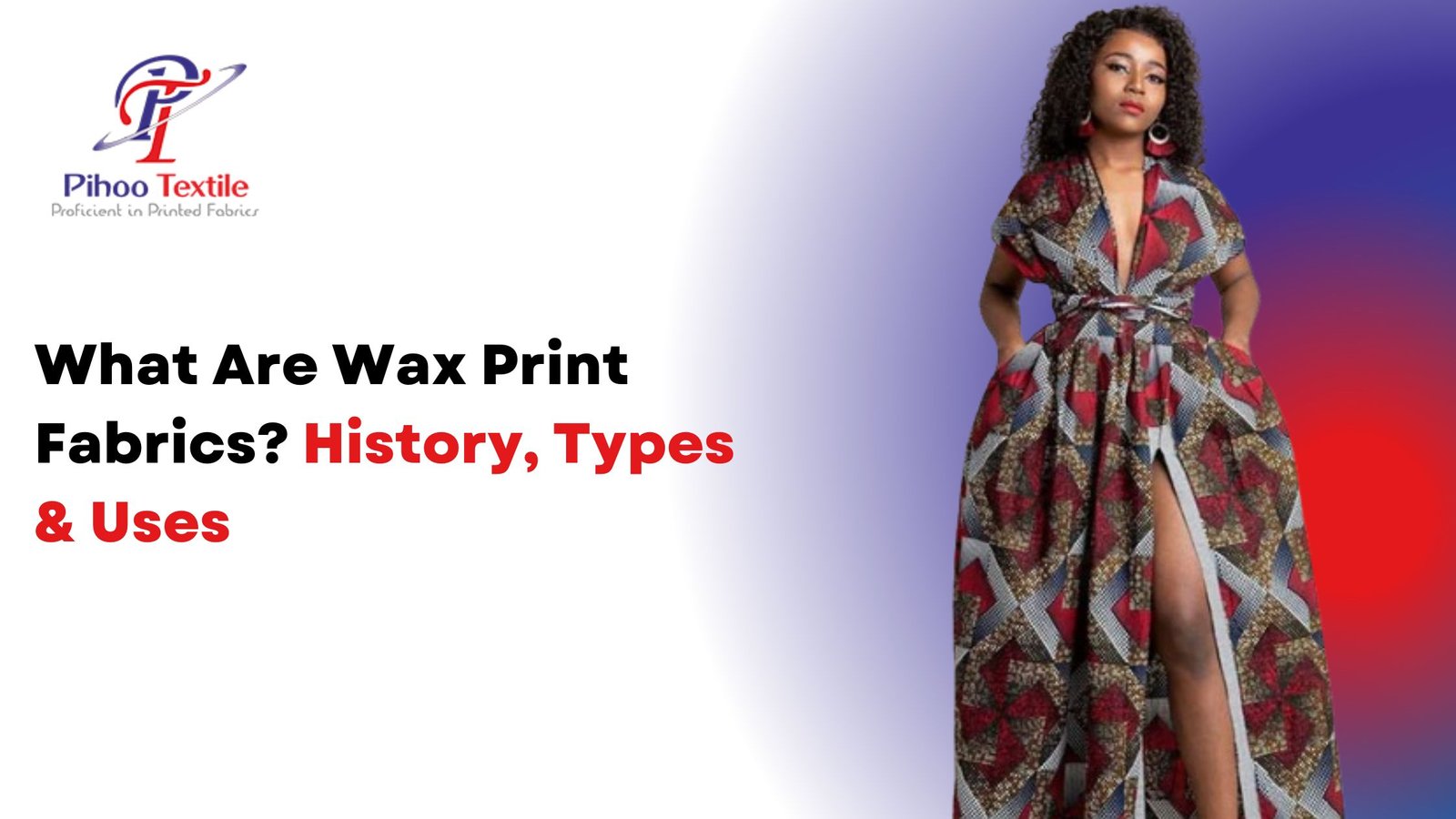What Are Wax Print Fabrics? History, Types & Uses
Introduction
Most people think wax print fabrics originated in Africa. They did not. These vibrant textiles with characteristic crackle patterns were rejected by their intended Indonesian market in the 1850s, only to become synonymous with African identity decades later. The irony runs deeper: over 100 million yards of “African” fabric sold annually in Ghana alone now comes from low-cost Asian imports, not authentic sources. Understanding what separates genuine wax prints from mass-produced imitations matters for designers, fashion enthusiasts, and home décor creators who need fabrics that maintain their vibrancy and structural integrity.
This guide explains wax print origins, production methods, quality categories, and practical applications.
Historical Origins of Wax Print Fabrics
The Indonesian Batik Connection
Wax print technology began as a Dutch attempt to mechanize Indonesian batik during colonial expansion. By the 1850s, textile factory owners received batik samples and developed machines to imitate the wax-resist dyeing process at industrial scale. Jean Baptiste Theodore Prévinaire modified a mechanical block-printing machine in 1854 to apply resin on both fabric sides, replacing hand-applied wax. Other manufacturers used roller printing technology from Scotland.
Market Rejection and Redirection
The mechanized fabrics failed in Indonesia because they lacked the distinctive wax smell of authentic batik. Starting in the 1880s, Dutch and Scottish trading vessels introduced these rejected textiles to West African ports. The Belanda Hitam, West Africans recruited to serve in Dutch colonial armies in Indonesia between 1831 and 1872, may have provided the initial market when they retired to Elmina in modern Ghana.
African Adoption and Cultural Integration
West African communities embraced the fabrics immediately. Women transformed wax prints into a communication system where specific patterns conveyed widely understood messages. By the mid-20th century, patterns became African-inspired rather than Indonesian-influenced, and African-owned production facilities emerged. The textiles achieved status as formal wear for leaders and wealthy populations.
Cultural Significance Beyond Fabric
Wax prints function as nonverbal communication tools among African women, carrying messages into public spaces. Patterns receive names based on personalities, cities, buildings, sayings, or special occasions. The fabrics represent capital goods for African women, retained based on perceived market value rather than just aesthetic appeal. Different colors and motifs hold specific meanings across various African cultures, connecting wearers to heritage and tradition.
Sub-Saharan Africa recorded annual wax print sales of 2.1 billion yards in 2016, with production costs of $2.6 billion and retail value reaching $4 billion. This economic scale demonstrates how deeply embedded these textiles are in African commerce and daily life.
Types and Quality Categories
Real Wax Prints
Authentic wax prints use a resin application process on both fabric sides before dye immersion. The resin repels dye in covered areas, and the process repeats for each color in the design. Cloth is boiled afterward to remove resin, which gets reused. Real wax prints display identical color intensity on front and back sides.
The characteristic “crackle” effect appears when resin develops small cracks during processing, allowing dye to penetrate in fine lines. This cracking creates the duo-color bubbling print effect that marks high-quality super wax fabrics. Authentic pieces are made from dense, fine cotton and cost more than alternatives due to lengthy production stages.
Fancy Prints and Imitations
Fancy fabrics are industrially produced imitations created through standard printing procedures rather than wax-resist methods. Also called imiwax, Java print, roller print, or le fancy, these versions print on one side only and feature more intense, richer colors than real wax prints. Production uses engraved metal rollers or rotary screen-printing processes.
Fancy prints cost significantly less, making wax-style fabrics accessible to consumers who cannot afford European imports. Manufacturers often mimic existing wax print designs but take more risks with experimental patterns due to lower production costs.
Common Patterns and Design Elements
Geometric and Natural Motifs
Design vocabulary includes geometric shapes like squares, triangles, and stripes combined with natural forms such as leaves, flowers, and animals. Bold, saturated colors dominate the palette, from fiery reds and yellows to deep blues and emerald greens. Each design reflects the continent’s diverse aesthetic preferences.
Named Patterns with Cultural Meaning
Producers print the manufacturer name, product designation, and design registration number on the selvage edge. This protects designs and attests to fabric quality. Some patterns achieve iconic status and are named after specific events, leaders, or cultural sayings.
Uses of Wax Print Fabrics
Traditional and Contemporary Fashion
Wax prints traditionally create clothing for celebrations, weddings, funerals, religious ceremonies, and cultural festivals. Modern applications extend to everyday wear, formal attire, and sportswear including dresses, shirts, pants, jackets, and accessories. Fabrics are sold in 12-yard full pieces or 6-yard half pieces.
Designers worldwide now incorporate African prints into collections, blending traditional patterns with contemporary silhouettes. This fusion increases global visibility while raising questions about cultural appropriation versus appreciation.
Home Décor Applications
Wax prints add cultural vibrancy to interior spaces through cushion covers, throws, tablecloths, curtains, and upholstery. The fabrics work best as accent pieces combined with neutral colors like white, beige, or black to balance visual intensity. The characteristic waxed appearance on both sides provides water resistance suitable for functional home items.
Craft and Accessory Projects
DIY enthusiasts use wax prints for bags, jewelry pouches, headbands, scarves, and bow ties. The fabric’s natural stiffness provides structure without additional interfacing. Online tutorials and workshops teach techniques for incorporating these versatile materials into custom projects.
How to Identify Authentic Wax Print Fabric
Check for identical color intensity on both fabric sides, a hallmark of genuine wax-resist production. Authentic pieces feel heavier and denser than standard cotton prints due to quality materials and processing. Look for manufacturer information printed on the selvage edge.
Real wax prints display the characteristic crackle pattern throughout the design. Fancy prints lack this feature and show color only on one surface. Test colorfastness by dampening a white cloth piece and ironing it against the wax print until both dry. Color transfer indicates poor quality that will bleed during washing.
Maintaining and Caring for Wax Print Fabrics
Washing Guidelines
Wash wax prints separately using mild detergent at temperatures not exceeding 30-40°C. Select non-spin or gentle cycles on washing machines. Hand washing preserves vibrant colors better than machine washing. Avoid harsh detergents, bleach, or stain removers that fade colors and damage the wax coating.
Drying and Storage
Air dry fabrics by securing them with pegs or clips that do not leave marks. Avoid machine dryers, as heat causes shrinkage and fabric damage. Iron wax prints upside down on medium heat to protect the surface pattern. Store unused fabric rolled rather than folded to prevent permanent creases in the wax coating.
Contemporary Relevance and Sustainability
Manufacturers increasingly adopt eco-friendly practices including organic cotton, non-toxic dyes, recycled offcuts, and fair trade principles. These efforts address environmental concerns while maintaining traditional aesthetic appeal. The global fashion industry’s adoption of wax prints expands market reach while creating demand for authentic, sustainably produced textiles.
FAQs
What makes wax prints different from regular printed cotton?
Wax prints use a resin-resist dyeing process that creates identical color intensity on both fabric sides, unlike standard prints that show color on one surface only. The resin creates a characteristic waxed texture and water resistance not found in regular cotton. Production complexity makes wax prints more expensive but significantly more durable.
Why are wax prints called African when they originated in the Netherlands?
Dutch manufacturers developed the fabrics for the Indonesian market in the 1850s but faced rejection there. West African communities embraced the textiles in the 1880s, transforming them into cultural symbols with African-specific patterns and meanings. By the mid-20th century, African ownership and design influence made the fabrics authentically African despite European production origins.
How can I tell if wax print fabric will fade after washing?
Dampen a white cloth and iron it against the wax print until both pieces dry completely. If color transfers to the white cloth, the fabric will bleed during washing. Quality wax prints maintain color through multiple wash cycles when cleaned properly with mild detergent in cold water.
Are fancy prints worth buying compared to real wax prints?
Fancy prints cost less and offer more diverse, experimental designs because production risks less investment. However, they print on one side only, lack the characteristic crackle effect, and may not maintain color as long as real wax prints. Choose based on intended use: fancy prints work for temporary fashion or décor, while real wax suits items requiring longevity.
What fabric weight should I choose for different projects?
Super wax fabrics made from exceptionally dense, fine cotton work best for structured garments and upholstery that need durability. Standard wax prints suit dresses, shirts, and home accessories. Lighter fancy prints fit flowing garments and decorative projects where structure matters less than visual impact.
Do wax prints shrink when washed?
Quality 100% cotton wax prints may shrink 2-3% during the first wash. Pre-wash fabric before cutting patterns to account for this shrinkage. The wax coating stabilizes fabric structure, resulting in less shrinkage than standard cotton. Always follow care instructions specific to the fabric type.
Conclusion
Wax print fabrics carry unique stories from failed colonial ventures to African cultural icons, from Indonesian batik imitations to globally recognized fashion statements. Quality matters more than cost when choosing fabrics that maintain their character through years of use. Browse authentic wax print collections and experience the difference genuine craftsmanship makes in finished projects.
Pihoo Textile sources certified wax print fabrics that meet international standards for quality, colorfastness, and authentic production methods. Every piece undergoes inspection to ensure proper weight, texture, and pattern clarity before reaching customers in India. Designers, boutiques, and home décor enthusiasts rely on consistent quality that performs as beautifully as it looks.
Ready to explore authentic wax print fabrics? Visit pihootextile.com to browse collections featuring traditional and contemporary patterns perfect for fashion, home décor, and creative projects. Place orders online with secure payment and reliable delivery across India.


